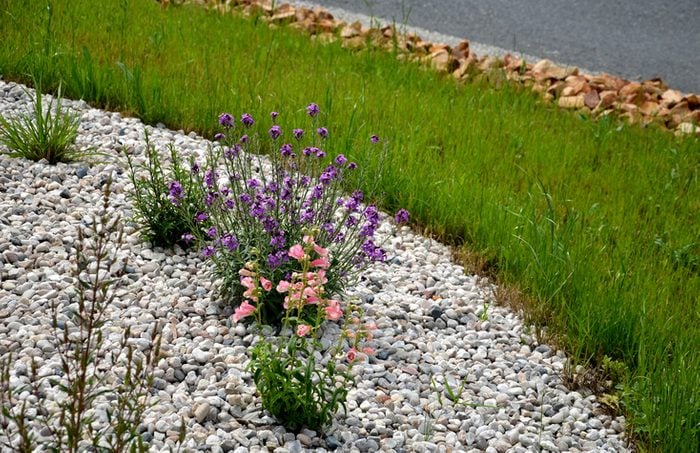Pea Gravel Flower Bed Tips You Need to Know
Updated: Mar. 03, 2024

Our experts walk us through the pros and cons of adding pea gravel to your flower beds.
On This Page
Is Pea Gravel Right for You?
Thinking of making the switch from mulch to pea gravel in your flower beds? I transitioned almost all of mine a few years ago and have never looked back.
I mulch a few beds in the front of my house, but the rest is pea gravel and I am so happy with the decision. To determine if pea gravel is the right choice for your yard, I spoke with two experts about the pros and cons of pea gravel, as well as installation and maintenance tips.
About the Experts
Tory J. Chlanda is a landscape designer and owner of Better View Landscapes, based in Northampton, Massachusetts. He has extensive experience in horticulture, design and installation.
Joyce Corbett owns Classic Courtyards in West Springfield, Massachusetts. She has more than forty years of landscaping design and installation experience.
What is Pea Gravel?
Pea gravel is named for its resemblance to the size and shape of peas, but it’s available in sizes from 1/8- to 3/4-inch, and in various colors.
Hardscaping enthusiasts popularized pea gravel for pathways and garden walks, but is it right for your flower bed? Here are some things to consider.
Pros of putting pea gravel in a flower bed
I switched from mulch to pea gravel mostly to save time and money. Mulch and pea gravel cost between $30 to $50 per cubic yard, but pea gravel doesn’t decompose like mulch does, so it doesn’t need annual replenishing. Since I switched to pea gravel three years ago, I saved hundreds of dollars and more than a few hours of time.
The small stones also facilitate superb drainage and erosion protection, so I used pea gravel on the sloped bed above my pool deck. Mulch used to wash down the hill and into the pool when it rained. Now, the pea gravel doesn’t budge, even in a heavy storm.
Another plus: Pea gravel deters critters in your flower beds. “They won’t usually bother to dig through it,” Corbett says.
Cons of putting pea gravel in a flower bed
While I’m a big fan of pea gravel, there are a few drawbacks to consider.
First, pea gravel is much heavier to load and move than mulch. It also doesn’t keep weeds down as well without outside help. “As a weed barrier stone isn’t great without using chemical weed controls like Preen and other granular pre-emergent weed controls,” Chlanda says.
Without proper edging, pea gravel tends to migrate onto your lawn, walkways or patio. It’s also not comfortable to walk on with bare feet.
Unlike mulch, pea gravel is a big commitment. If you have a change of heart, be prepared for the tedious process of removing it by hand. I’ve done it. It’s not pleasant.
Another thing to consider: “Some plants might not like the environment stone creates,” Chlanda says. Pea gravel traps heat, which can be problematic in hot weather zones or with heat-intolerant plants.
Finally, pea gravel doesn’t add nutrients to the soil like organic mulch does as it decomposes. If this is important to you, then pea gravel may not be the best solution for your garden.
Installing Pea Gravel in Flower Beds
Whether you’re creating a new flower bed or transitioning an existing one, start by making room for the new layer of pea gravel. Dig and remove the dirt down three to four inches. If a new bed, remove any grass.
Next, install edging at least one inch higher than the pea gravel will be to keep it all in place. Corbett recommends putting down a three-inch layer of pea gravel, so use that as your guide. Metal or plastic garden edging will work, or you can use bricks or pavers.
You should also lay landscape fabric as a weed barrier, since you shouldn’t place pea gravel directly on dirt. If this is a new garden bed, take your flower plants and set them on the landscape fabric where you’d like them. Use a utility knife to cut an “X” where you want each plant, dig an appropriate hole and plant the flowers. If it’s an existing bed, cut the fabric to fit around the plantings.
Finally, install the pea gravel, making sure that it’s below the edging height. Use a metal garden rake to evenly distribute it across the bed.
Pea gravel is labor-intensive to install. If you have a lot to put down, consider hiring the job out. Another option: Use a motorized wheelbarrow to move the material. “Otherwise you’re going to have a very sore back,” Chlanda says.
Maintaining Pea Gravel and Keeping It In Place
“Pea gravel is pretty low-maintenance, but does need regular attention to keep the weeds out,” Corbett says. “Put down a pre-emergent weed control product in early spring and again every three months through the growing season.”
Corbett also recommends keeping dirt and debris out of the rock as much as possible, “because that’s where weeds can start to sprout.”
These practices go a long way to keeping your pea gravel beds looking great, but some weeds are inevitable. “Hand weed or chemically treat the ones that do pop up,” Chlanda says.
The stones will settle over time, so you may need to refresh them every four to five years. Make sure your edging border is in good shape to keep your pea gravel in place.
